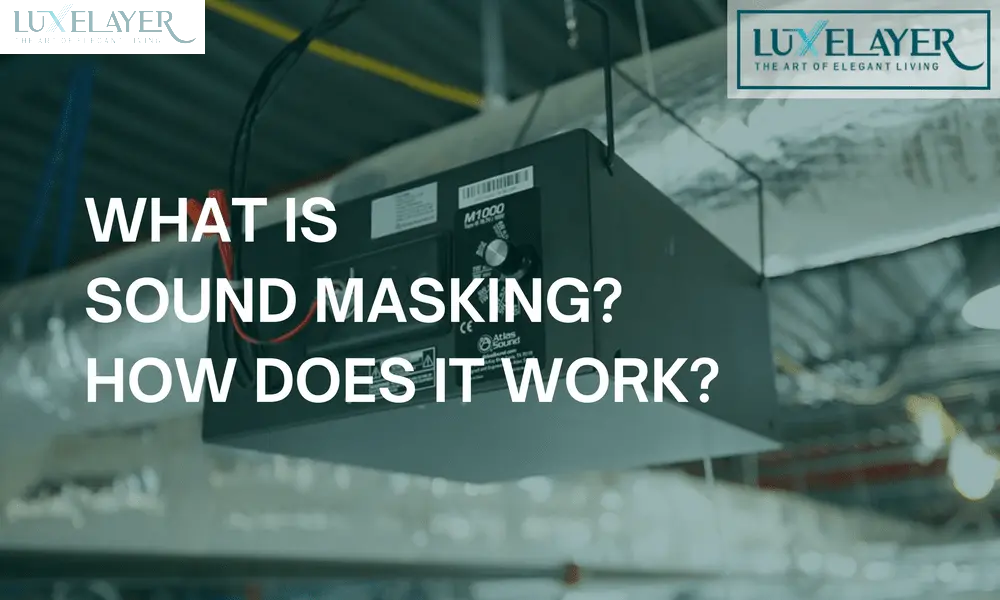In modern office environments and other shared spaces, managing noise levels can be challenging. By reducing noise distractions and enhancing speech privacy, sound masking technology creates a more consistent and comfortable acoustic environment. This guide will explain what sound masking is, how it works, its benefits, and address common FAQs.
What is Sound Masking?
Definition and Purpose
Sound masking involves adding a background sound, often referred to as [pink noise,] to an environment to cover up unwanted noises. Sound masking specifically blends into the background and is less noticeable, unlike white noise, which includes all frequencies at equal intensity. The primary purpose of sound masking is to increase speech privacy, reduce distractions, and improve overall comfort in a space.
Difference Between Sound Masking and White Noise
White noise contains all frequencies at equal intensity, making it more noticeable and potentially irritating. On the other hand, sound masking tunes itself to the frequencies of human speech, effectively covering conversations without being intrusive.
How Does Sound Masking Work?
The Science Behind Sound Masking
Sound masking systems use speakers (emitters) to distribute a carefully engineered sound throughout a space. Unintentional listeners find conversations less intelligible due to the tuning of this sound to the frequency and amplitude of human speech.
- Emitters: small speakers installed in ceilings or walls.
- Control Systems: Manage the volume and frequency of the masking sound to suit different areas.
- Sound Profiles: The masking sound is adjusted to blend into the environment and provide uniform coverage.
Key Components
- Sound Generators: Produce the masking noise.
- Amplifiers: Boost the sound to the required level.
- Speakers/Emitters: Distribute the sound evenly across the space.
- Control Units: Allow for adjustments and customization of sound levels.
How It Reduces Distractions
By introducing a consistent background sound, sound masking raises the ambient noise level in an environment, making speech noise less intelligible and therefore less distracting. This process diminishes the radius of distraction, thereby enhancing the audibility and comprehension of conversations.
Benefits of Sound Masking
Enhanced Speech Privacy
Sound masking makes it difficult for unintended listeners to understand conversations, thereby protecting confidential information and enhancing privacy.
Increased Productivity
By reducing distractions, employees can focus better on their tasks, leading to increased productivity.
Improved Comfort
A consistent background sound can make an environment more comfortable by masking sudden, disruptive noises.
Flexibility and Scalability
Sound masking systems are scalable and adaptable, making them suitable for a variety of environments, from small offices to large open-plan spaces.
Applications of Sound Masking
Open-Plan Offices
Open offices often suffer from noise distractions. Sound masking helps create a more conducive working environment by reducing the intelligibility of speech and other noises.
Private Offices and Meeting Rooms
Ensuring conversations remain private is crucial in settings like legal firms or HR departments. Sound masking helps achieve this.
Healthcare Facilities
In hospitals and clinics, sound masking can protect patient confidentiality and reduce stress by minimizing intrusive noises.
Call Centers
With numerous conversations happening simultaneously, sound masking helps reduce background noise and improve the clarity of calls.
Financial Institutions
Banks and financial institutions use sound masking to ensure client information remains confidential during transactions.
Installing Sound Masking Systems
DIY vs. Professional Installation
Larger or more complex projects may benefit from professional installation to ensure optimal placement and performance, even though some sound masking systems are easy to DIY install.
Steps for Installation
- Assessment: Evaluate the space to determine the number of emitters needed and their optimal placement.
- Placement: To ensure even coverage, install emitters in key locations in the ceiling or walls.
- Calibration: Adjust the control units to set the appropriate volume and frequency levels for the space.
- Testing: Conduct sound tests to ensure the system is effectively masking unwanted noise without being intrusive.
Common Mistakes to Avoid
Overcrowding
Avoid placing too many emitters in one area, as this can lead to an overly dampened sound environment. Distribute emitters evenly for balanced acoustics.
Ignoring Reflection Points
Failing to identify and cover key reflection points can result in suboptimal sound quality. Always prioritize these areas during installation.
Improper Calibration
Make sure you calibrate the sound masking system correctly to prevent the masking from sounding too loud or soft, as this can reduce its effectiveness.
Conclusion
Sound masking is a powerful tool for creating comfortable and productive environments by reducing noise distractions and enhancing speech privacy. Open-plan offices, healthcare facilities, and financial institutions can tailor sound masking systems to meet specific needs. LuxeLayer offers advanced sound masking solutions that ensure your space remains private and productive.
FAQs
What is the difference between sound masking and white noise?
Specifically designed to mask human speech frequencies, sound masking is less intrusive than white noise, which includes all frequencies at equal intensity.
How is the sound masking installed?
Sound masking systems involve installing emitters in the ceiling or walls, connected to a central control system that manages the sound output.
Can sound masking be adjusted?
Yes, sound masking systems are highly customizable, allowing for adjustments in volume and frequency to suit different environments.
Is sound masking noticeable?
Sound masking, when properly implemented, blends into the background, making it unobtrusive and often unnoticeable to occupants.
How does sound masking improve productivity?
By reducing noise distractions, employees can maintain focus and concentration, leading to higher productivity levels.
Where can sound masking be used?
Open-plan offices, private offices, healthcare facilities, call centers, financial institutions, and more can all use sound masking.


